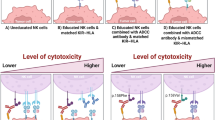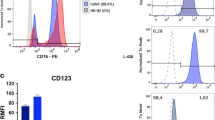Abstract
The recent success of checkpoint inhibitors in the treatment of Merkel cell carcinoma (MCC) confirms that MCC tumors can be immunogenic. However, no treatment directly targeting the tumor is available for use in combination with these checkpoint inhibitors to enhance their efficacity. This study was carried out to characterize MCC line sensitivity to cellular lysis and to identify cell surface antigens that could be used for direct targeting of this tumor. For five representative MCC lines, the absence or low expression of MICA, MICB, HLA-I, and ICAM-1 was associated with low level of recognition by NK cells and T lymphocytes. However, expression of HLA-I and ICAM-1 and sensitivity to cellular lysis could be restored or increased after exposure to INFγ. We tested 41 antibodies specific for 41 different antigens using a novel antibody-dependent cellular cytotoxicity (ADCC) screening system for target antigens. Anti-CD326 (EpCAM) was the only antibody capable of inducing ADCC on the five MCC lines tested. Because MCC tumors are often directly accessible, local pharmacologic manipulation to restore HLA class-I and ICAM-1 cell surface expression (and thus sensitivity to cell lysis) can potentially benefit immune therapeutic intervention. In line with this, our observation that ADCC against EpCAM can induce lysis of MCC lines and suggests that therapeutic targeting of this antigen deserves to be explored further.




Similar content being viewed by others
Abbreviations
- ADCC:
-
Antibody-dependent cellular cytotoxicity
- ATCC:
-
American-type culture collection
- CK:
-
Cytokeratin
- EpCAM:
-
Epithelial cell adhesion molecule
- FFPE:
-
Formalin-fixed, paraffin-embedded
- LFA-1:
-
Lymphocyte function-associated antigen 1
- LFB:
-
Laboratoire français du fractionnement et des biotechnologies
- MCC:
-
Merkel cell carcinoma
- MCPyV:
-
Merkel cell polyomavirus
- MIC:
-
MHC class-I polypeptide-related sequence
- NKG2D:
-
Natural killer group 2D
- RFI:
-
Relative fluorescence intensity
- TTF-1:
-
Thyroid transcription factor-1
References
Fitzgerald TL, Dennis S, Kachare SD et al (2015) Dramatic increase in the incidence and mortality from Merkel cell carcinoma in the United States. Am Surg 81:802–806
Lebbe C, Becker JC, Grob JJ et al (2015) Diagnosis and treatment of Merkel cell carcinoma. European consensus-based interdisciplinary guideline. Eur J Cancer 51:2396–2403
Youlden DR, Soyer HP, Youl PH et al (2014) Incidence and survival for Merkel cell carcinoma in Queensland, Australia, 1993–2010. JAMA Dermatol 150:864–872
Feng H, Shuda M, Chang Y et al (2008) Clonal integration of a polyomavirus in human Merkel cell carcinoma. Science 319:1096–1100
Santos-Juanes J, Fernandez-Vega I, Fuentes N et al (2015) Merkel cell carcinoma and Merkel cell polyomavirus: a systematic review and meta-analysis. Br J Dermatol 173:42–49
Rodig SJ, Cheng J, Wardzala J et al (2012) Improved detection suggests all Merkel cell carcinomas harbor Merkel polyomavirus. J Clin Investig 122:4645–4653
Banks PD, Sandhu S, Gyorki DE et al (2016) Recent insights and advances in the management of Merkel cell carcinoma. J Oncol Pract 12:637–646
Afanasiev OK, Yelistratova L, Miller N et al (2013) Merkel polyomavirus-specific T cells fluctuate with merkel cell carcinoma burden and express therapeutically targetable PD-1 and Tim-3 exhaustion markers. Clin Cancer Res 19:5351–5360
Rubel JR, Milford EL, Abdi R (2002) Cutaneous neoplasms in renal transplant recipients. Eur J Dermatol 12:532–535
Engels EA, Frisch M, Goedert JJ et al (2002) Merkel cell carcinoma and HIV infection. Lancet 359:497–498
Ma JE, Brewer JD (2014) Merkel cell carcinoma in immunosuppressed patients. Cancers (Basel) 6:1328–1350
Guler-Nizam E, Leiter U, Metzler G et al (2009) Clinical course and prognostic factors of Merkel cell carcinoma of the skin. Br J Dermatol 161:90–94
Tarantola TI, Vallow LA, Halyard MY et al (2013) Prognostic factors in Merkel cell carcinoma: analysis of 240 cases. J Am Acad Dermatol 68:425–432
Paulson KG, Iyer JG, Blom A et al (2013) Systemic immune suppression predicts diminished Merkel cell carcinoma-specific survival independent of stage. J Investig Dermatol 133:642–646
Feldmeyer L, Hudgens CW, Ray-Lyons G et al (2016) Density, distribution, and composition of immune infiltrates correlate with survival in Merkel cell carcinoma. Clin Cancer Res 22:5553–5563
Nghiem PT, Bhatia S, Lipson EJ et al (2016) PD-1 blockade with pembrolizumab in advanced Merkel-cell carcinoma. N Engl J Med 374:2542–2552
Kaufman HL, Russell J, Hamid O et al (2016) Avelumab in patients with chemotherapy-refractory metastatic Merkel cell carcinoma: a multicentre, single-group, open-label, phase 2 trial. Lancet Oncol 17:1374–1385
Boyerinas B, Jochems C, Fantini M et al (2015) Antibody-dependent cellular cytotoxicity activity of a novel anti-PD-L1 antibody avelumab (MSB0010718C) on human tumor cells. Cancer Immunol Res 3:1148–1157
Clemenceau B, Vivien R, Pellat C et al. (2013) The human natural killer cytotoxic cell line NK-92, once armed with a murine CD16 receptor, represents a convenient cellular tool for the screening of mouse mAbs according to their ADCC potential. MAbs 5:587–594
Rosen ST, Gould VE, Salwen HR et al (1987) Establishment and characterization of a neuroendocrine skin carcinoma cell line. Lab Investig 56:302–312
Guastafierro A, Feng H, Thant M et al (2013) Characterization of an early passage Merkel cell polyomavirus-positive Merkel cell carcinoma cell line, MS-1, and its growth in NOD scid gamma mice. J Virol Methods 187:6–14
Leonard JH, Dash P, Holland P et al (1995) Characterisation of four Merkel cell carcinoma adherent cell lines. Int J Cancer 60:100–107
Ronan SG, Green AD, Shilkaitis A et al (1993) Merkel cell carcinoma: in vitro and in vivo characteristics of a new cell line. J Am Acad Dermatol 29:715–722
Leonard JH, Bell JR, Kearsley JH (1993) Characterization of cell lines established from Merkel-cell (“small-cell”) carcinoma of the skin. Int J Cancer 55:803–810
Van Gele M, Leonard JH, Van Roy N et al (2002) Combined karyotyping, CGH and M-FISH analysis allows detailed characterization of unidentified chromosomal rearrangements in Merkel cell carcinoma. Int J Cancer 101:137–145
Houben R, Dreher C, Angermeyer S et al (2013) Mechanisms of p53 restriction in Merkel cell carcinoma cells are independent of the Merkel cell polyoma virus T antigens. J Investig Dermatol 133:2453–2460
Touze A, Gaitan J, Maruani A et al (2009) Merkel cell polyomavirus strains in patients with merkel cell carcinoma. Emerg Infect Dis 15:960–962
Daily K, Coxon A, Williams JS et al (2015) Assessment of cancer cell line representativeness using microarrays for Merkel cell carcinoma. J Investig Dermatol 135:1138–1146
Chapuis AG, Afanasiev OK, Iyer JG et al (2014) Regression of metastatic Merkel cell carcinoma following transfer of polyomavirus-specific T cells and therapies capable of re-inducing HLA class-I. Cancer Immunol Res 2:27–36
Ritter C, Fan K, Paulson KG et al (2016) Reversal of epigenetic silencing of MHC class I chain-related protein A and B improves immune recognition of Merkel cell carcinoma. Sci Rep 6:21678
Jimenez FJ, Burchette JL Jr, Grichnik JM et al (1995) Ber-EP4 immunoreactivity in normal skin and cutaneous neoplasms. Mod Pathol 8:854–858
Baeuerle PA, Gires O (2007) EpCAM (CD326) finding its role in cancer. Br J Cancer 96:417–423
Kurzen H, Kaul S, Egner U et al (2003) Expression of MUC 1 and Ep-CAM in Merkel cell carcinomas: implications for immunotherapy. Arch Dermatol Res 295:146–154
Gaiser MR, Daily K, Hoffmann J et al (2015) Evaluating blood levels of neuron specific enolase, chromogranin A, and circulating tumor cells as Merkel cell carcinoma biomarkers. Oncotarget 6:26472–26482
Acknowledgements
We thank the Cytometry Facility Cytocell from Nantes for expert technical assistance. We are also indebted to Drs. J. Becker and R. Houben (University Hospital Würzburg, Würzburg, Germany) for the MCC cell lines MKL-2, PeTa, and WaGa. We also thank Richard Breathnach for careful edition of the manuscript.
Funding
This work was supported by Cancéropole Grand Ouest (Project POCAME), and institutional Grant from Inserm.
Author information
Authors and Affiliations
Contributions
The study was conceived and coordinated by HV and BC. The manuscript was prepared by HV, BC, and JO. JO, TK, MS, HB, PA, and RV contributed to acquisition of data and interpretation of results. AT and NL provided intellectual contributions. All authors read and approved the manuscript.
Corresponding author
Ethics declarations
Conflict of interest
The authors declare that they have no conflict of interest. The study was approved by the Comité de Protection des Personnes TOURS, Région Centre-Ouest 1 (CPP n° 2009-S5). Peripheral blood mononuclear cells (PBMCs) were obtained from blood donors at the Etablissement Français du Sang (EFS) with informed consent (blood products transfer agreement relating to biomedical research protocol 97/5-B—DAF 03/4868).
Electronic supplementary material
Below is the link to the electronic supplementary material.
Rights and permissions
About this article
Cite this article
Ollier, J., Kervarrec, T., Samimi, M. et al. Merkel cell carcinoma and cellular cytotoxicity: sensitivity to cellular lysis and screening for potential target antigens suitable for antibody-dependent cellular cytotoxicity. Cancer Immunol Immunother 67, 1209–1219 (2018). https://doi.org/10.1007/s00262-018-2176-2
Received:
Accepted:
Published:
Issue Date:
DOI: https://doi.org/10.1007/s00262-018-2176-2




